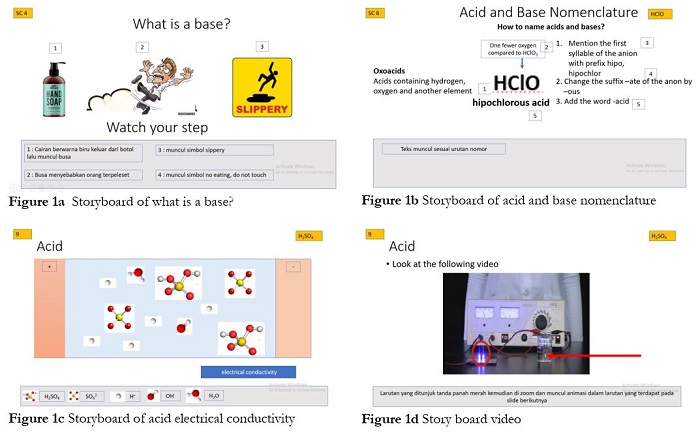
Smartchem: An Android Application for Learning Multiple Representations of Acid-Base Chemistry
Abstract
Full Text:
DOWNLOAD PDFReferences
Aiken, L. R. (1985). Three coefficients for analyzing the reliability and validity of ratings. Educational and psychological measurement, 45(1), 131-142.
Andriani, T. (2016). Sistem Pembelajaran Berbasis Teknologi Informasi dan Komunikasi. Sosial Budaya, 12(1), 117-126.
Ardac, D., & Akaygun, S. (2004). Effectiveness of Multimedia-Based Instruction That Emphasizes Molecular Representations on Students’ Understanding of Chemical Change. Journal of Research in Science Teaching, 41(4), 317–337. https://doi.org/10.1002/tea.20005
Cahyani, I., & Nasruddin, H. (2019). The Development Of Students Worksheet Oriented Problem Solving To Train Creative Thinking Skills In Acid Base Matter For 11th Grade. Unesa Journal Of Chemical Education, 8(2).
Calik, M., & Ayas, A. (2005). A comparison of level of understanding of eighth‐grade students and science student teachers related to selected chemistry concepts. Journal of Research in Science Teaching, 42(6), 638-667.
Dunn, J. G. (1999). Assessing item content-relevance in sport psychology scale-construction research: Issues and recommendations. Measurement in Physical Education and Exercise Science, 3(1), 15-36.
Eliyawati, Rohman, I., & Kadarohman, A. (2018). The effect of learning multimedia on students’ understanding of macroscopic, sub-microscopic, and symbolic levels in electrolyte and nonelectrolyte. Journal of Physics: Conference Series, 1013(1). https://doi.org/10.1088/1742-6596/1013/1/012002
Gkitzia, V., Salta, K., & Tzougraki, C. (2011). Development and application of suitable criteria for the evaluation of chemical representations in school textbooks. Chemistry Education Research and Practice, 12(1), 5-14.
Helsy, I., & Andriyani, L. (2017). Pengembangan Bahan Ajar Pada Materi Kesetimbangan Kimia Berorientasi Multipel Representasi Kimia. Jurnal Tadris Kimiya, 2(1), 104. https://doi.org/10.15575/jta.v2i1.1365
Ibrahim, F., Sugiyarto, K. H., & Ikhsan, J. The Development of HTML5-based Virtual Chemistry Laboratory (VICH-LAB) Media on Acid-Base Material to Improve High School Students' Self-Efficacy.
Istijabatun, S. (2008). Pengaruh Pengetahuan Alam terhadap Pemahaman Mata Pelajaran Kimia. Jurnal Inovasi Pendidikan Kimia, 2(2), 323–329. https://doi.org/10.1007/978-0-387-72659-5_2
Kamkhou, P., & Yuenyoung, C. (2019). Magnet and Pin kit: Connection Symbolic and Submicroscopic Representations of Lewis dot structure and Molecular geometry. Journal of Physics: Conference Series, 1340(1). https://doi.org/10.1088/1742-6596/1340/1/012070
Kumar, R. (2011). Research Methodology Third Edition A Step By Step Guide For Beginner (3rd ed.). SAGE Publications.
Kumar, S. (2013). International Journal on New Trends in Education and Their Implications (IJONTE), 4(4), 214.
Leow, F. T., & Neo, M. (2014). Interactive multimedia learning: Innovating classroom education in a Malaysian university. Turkish Online Journal of Educational Technology-TOJET, 13(2), 99-110.
Liao, Y., Loures, E. R., Venâncio, A., Brezinski, G., & Deschamps, F. (2018). The impact of the fourth industrial revolution: a cross-country/region comparison. Production, 28(0). https://doi.org/10.1590/0103-6513.20180061
Lin, H. M., Chen, W. J., & Nien, S. F. (2014). The Study of Achievement and Motivation by E-Learning-A Case Study. International Journal of information and education technology, 4(5), 421.
Liu, S. H., Liao, H. L., & Pratt, J. A. (2009). Impact of media richness and flow on e-learning technology acceptance. Computers & Education, 52(3), 599-607.
Mewengkang, A., Liando, O. E. S., Ngodu, M. R., Moningkey, E. R. S., & Wantania, T. (2019). Android Based Application for Children Learning with Indonesian and Mongondow Language. 5th UPI International Conference on Technical and Vocational Education and Training (ICTVET 2018). Atlantis Press.
Owston, R., York, D., & Murtha, S. (2013). Student perceptions and achievement in a university blended learning strategic initiative. The Internet and Higher Education, 18, 38-46.
Rachmadtullah, R., Zulela, Ms., & Sumantri, M. S. (2018). Development of computer-based interactive multimedia: study on learning in elementary education. International Journal of Engineering & Technology, 7(4), 2035-2038.
Raviolo, A. (2001). Assessing Students ’ Conceptual Understanding of Solubility Equilibrium. Journal of Chemical Education, 78(5), 629–631.
Roche Allred, Z. D., & Bretz, S. L. (2019). University chemistry students’ interpretations of multiple representations of the helium atom. Chemistry Education Research and Practice. https://doi.org/10.1039/c8rp00296g
Sunyono, S., & Meristin, A. (2018). The Effect of Multiple Representation-Based Learning (MRL) to Increase Students’ Understanding of Chemical Bonding Concepts. Jurnal Pendidikan IPA Indonesia, 7(4), 399–406. https://doi.org/10.15294/jpii.v7i4.16219
Treagust, D. F., Chittleborough, G., & Mamiala, T. L. (2003). The role of submicroscopic and symbolic representations in chemical explanations. International Journal of Science Education, 25(11), 1353–1368. https://doi.org/10.1080/0950069032000070306
Umachandran, D. K., Jurcic, I., & Ferdinand-James, D. (2018). Gearing up education towards Industry 4.0. International Journal of Computers & Technology, 17(2), 7305–7311. https://doi.org/10.24297/ijct.v17i2.7754
Wu, H. K., Krajcik, J. S., & Soloway, E. (2001). Promoting understanding of chemical representations: Students’ use of a visualization tool in the classroom. Journal of Research in Science Teaching, 38(7), 821–842. https://doi.org/10.1002/tea.1033
DOI: https://doi.org/10.17509/jsl.v3i3.23280
Refbacks
- There are currently no refbacks.
Copyright (c) 2020 Eliyawat Eliyawati, Rika Rafikah Agustin, Yustika Sya’bandari, Rossy Andini Herindra Putri

This work is licensed under a Creative Commons Attribution-ShareAlike 4.0 International License.


Jl. Dr. Setiabudhi 229 Bandung 40154, West Java, Indonesia











